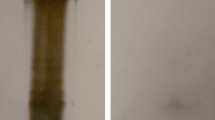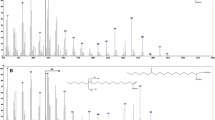Abstract
Lipids of the marine oomycetous microbe Haliphthoros philippinensis were characterized by chromatographic and spectroscopic techniques. Total lipid content of this organism was relatively low and not very responsive to manipulation of the culture conditions. Neutral lipid comprised 21% of the total lipid and the polar lipids were mainly phosphatidylcholine (44%), phosphatidylethanolamine (15%), and a ceramide-phosphorylethanolamine (19%). Palmitic (16:0) was the primary saturated fatty acid at 25% of the total fatty acids, and arachidonic acid (20:4n-6, ARA) and eicosapentaenoic acid (20:5n-3, EPA) were the major unsaturated fatty acids at 19 and 21%, respectively. Fucosterol was the principal sterol at 59% of the total sterols. The effects of several cultivation variables on growth and EPA production by this species were investigated. Among those tested, glucose and sodium glutamate were the most efficient carbon and nitrogen sources for growth, respectively. When the mycelium was cultivated for 6 d to produce biomass under optimal growth conditions, and then transferred to low temperature for an additional 13 d without glucose, the EPA content reached 31% of the total fatty acids and the yield was 203 mg/L. When the same experiment was performed with glucose supplementation during the low-temperature phase, EPA composed 27% of total fatty acids and yield reached 316 mg/L, or a 285% increase over that from mycelium cultured for 6 d at 24°C, and 56% over that cultured at 16°C for 13 d. ARA production did not respond accordingly.
Similar content being viewed by others
References
Lands, W.E.M., The Fate of Polyunsaturated Fatty Acids, in Health Effects of Polyunsaturated Fatty Acids in Seafoods, edited by A.P. Simopoulos, R.R. Kifer, and R.E. Martin, Academic Press Inc., Orlando, 1986, pp. 319–351.
Simopoulos, A.P., Summary of the NATO Advanced Research Workshop on Dietary Omega-3 and Omega-6 Fatty Acids. Biological Effects and Nutritional Essentialities, J. Nutr. 119:521–528 (1989).
Yongmanitchai, W., and Ward, O.P., Growth and Eicosapentaenoic Acid Production by Phaeodacylum tricorntum in Batch and Continuous Culture Systems, J. Am. Oil Chem. Soc. 69:584–590 (1992).
Cohen, Z., Production Potential of Eicosapentaenoic Acid by Monodus subterraneous, Ibid.:941–945 (1994).
Weete, J.D., M. Fuller, M.Q. Huang, and S. Gandhi, Fatty Acids and Sterols of Selected Hypochytriomyces and Chytridiomycetes, Exp. Mycol. 13:183–195 (1992).
Bajpai, P.K., P. Bajpai, and O.P. Ward, Optimization of Culture Conditions for Production of Eicosapentaenoic Acid by Mortierella elongata NRRL 5513, J. Ind. Microbiol. 9:11–18 (1992).
Yamada, H., S. Shimizu, and Y. Shinmen, Production of Arachidonic Acid by Mortierella elongata IS-5, Agric. Biol. Chem. 51:785–790 (1987).
Shimizu, S., A. Kawashima, Y. Shinmen, K. Akimoto, and H. Yamada, Production of Eicosapentaenoic Acid by Mortierella Fungi, J. Am. Oil Chem. Soc. 65:1455–1459 (1988).
Gellerman, T.L., and H. Schlenk, Methyl-Directed Desaturation of Arachidonic to Eicosapentaenoic Acid in the Fungus, Saprolegnia parasitica, Biochim. Biophys. Acta 573:23–30 (1979).
Gandhi, S.R., and J.D. Weete, Production of the Polyunsaturated Fatty Acids Arachidonic Acid and Eicosapentaenoic Acid by the Fungus Pythium ultimum, J. Gen. Microbiol. 137:1825–1830 (1991).
O’Brien, D.J., M.J. Kurantz, and R. Kwoczak, Production of Eicosapentaenoic Acid by the Filamentous Fungus Pythium irregulare, Appl. Microbiol. Biotechnol. 40:211–214 (1993).
Shirasaka, N., and S. Shimizu, Production of Eicosapentaenoic Acid by Saprolegnia 28YTF-1, J. Am. Oil Chem. Soc. 72:1545–1549 (1995).
Bajpai, P.K., P. Bajpai, and O.P. Ward, Optimization of Production of Docosahexaenoic Acid (DHA) by Thraustochytrium aureum ATCC 34303, Ibid.:509–513 (1991).
Bajpai, P., P.K. Bajpai, and O.P. Ward, Production of Docosahexaenoic Acid by Thraustochytrium aureum, Appl. Microbiol. Biotechnol. 35:706–710 (1991).
Kendrick, A., and C. Ratledge, Lipids of Selected Molds Grown for Production of n-3 and n-6 Polyunsaturated Fatty Acids, Lipids 27:15–20 (1992).
Weete, J.D., H. Kim, S.R. Gandhi, Y. Wang, and R. Dute, Lipids and Ultrastructure of Thraustochytrium sp. ATCC 26185, Ibid.:839–845 (1997).
Yoguchi, T., S. Tanaka, T. Yokochi, T. Nakahara, and T. Higashihara, Production of High Yields of Docosahexaenoic Acid by Schizochytrium Strain SR21, J. Am. Oil Chem. Soc. 74:1431–1434 (1997).
Grima, E.M., J.A.S. Perez, J.L.G. Sanchez, F.G. Camacho, and D.L. Alonso, EPA from Isochrysis galbana. Growth Conditions and Productivity, Proc. Biochem. 27:299–305 (1992).
Cohen, Z., The Production Potential of Eicosapentaenoic Acid and Arachidonic Acid by the Red Alga Porphyridium cruentum, J. Am. Oil Chem. Soc. 67:916–920 (1990).
Ward, O.P., Microbial production of long-chain PUFA, INFORM 6:683–688 (1995).
Vogel, H.J., Distribution of Lysine Pathways Among Fungi: Evolutionary Implications, Amer. Naturalist 98:435–445 (1984).
Bligh, E.G., and W.J. Dyer, A Rapid Method for Total Lipid Extraction and Purification, Can. J. Biochem. Physiol. 37:911–917 (1959).
Kates, M., Techniques of Lipidology, Part 2, Elsevier, Amsterdam, 1986, Vol. 3, pp. 106–107.
Siejo, L., T.E. Merchant, L.T.M. Van der Ven, B.D. Minsky, and T. Glonek, Meningioma Phospholipid Profiles Measured by 31P-NMR Spectroscopy, Lipids 31:357–369 (1994).
Meneses, P., and T. Glonek, High Resolution 31P-NMR of Extracted Phospholipids, J. Lipid Res. 29:679–689 (1998).
Moreau, R.A., D.H. Young, P.O. Danis, M.J. Powell, C. Quinn, and K. Beshah, Identification of Ceramide-Phosphorylethanolamine and Other Lipids in Oomycete Fungi: Pythium ultimum, Phytophthora infestans, and Phytophthora capsici, Lipids 33:307–317 (1998).
Brooks, C.J.W., E.C. Horning, and J.S. Young, Characterization of Sterols by Gas Chromatography-Mass Spectrometry of the Trimethylsilyl Ethers, Lipids. 3:391–402 (1968).
McCorkindale, N.J., S.A. Hutchinson, B.A. Pursey, W.T. Scott, and R. Wheeler, A Comparison of the Types of Sterol Found in Species of the Saprolegniales and Leptomitales with Those Found in Some Other Phycomycetes, Phytochemistry 8:861–867 (1969).
Warner, S.A., G.W. Savocool, and A.J. Domnas, Sterols of Selected Species of Oomycetes and Hyphochytridiomycetes, Mycologia 75:285–291 (1983).
Shimizu, S., Y. Shinmen, K. Akimoto, and H. Yamada, Fungal Mycelia as a Novel Source of Eicosapentaenoic Acid, Biochem. Biophys. Res. Commun. 150:335–341 (1988).
Latge, J.P., and C.D. Bievre, Lipid Composition of Entomophthora obscura Hall & Dunn, J. Gen. Microbiol. 121:151–158 (1980).
Jareonkitmongkoi, S., S. Shimizu, and H. Yamada, Production of an Eicosapentaenoic Acid-Containing Oil by a Δ12 Desaturase-Defective Mutant of Mortierella alpina IS-4, J. Am. Oil Chem. Soc. 69:119–123 (1993).
Shimizu, S., K. Akimoto, H. Kawashima, Y. Shinmen, and H. Yamada, Microbial Conversion of an Oil Containing Alpha-Linolenic Acid to an Oil Containing Eicosapentaenoic Acid, J. Am. Oil Chem. Soc. 66:237–241 (1989).
Lindberg, A.M., and G. Molen, Effect of Temperature and Glucose Supply on the Production of Polyunsaturated Fatty Acids by the Fungus Mortierella alpina CBS 343.66 in Fermentor Cultures, Appl. Microbiol. Biotechnol. 39:450–455 (1993).
Yazawa, K., K. Araki, N. Okazaki, K. Watanabe, C. Ishikawa, A. Inoue, N. Numao, and K. Kondo, Production of Eicosapentaenoic Acid by Marine Bacteria, J. Biochem. 103:5–7 (1988).
Akimoto, M., T. Ishii, K. Yamagaki, K. Ohtaguchi, K. Koide, and K. Yazawa, Production of Eicosapentaenoic Acid by a Bacterium Isolated from Mackerel Intestines, J. Am. Oil Chem. Soc. 67:911–915 (1990).
Author information
Authors and Affiliations
Corresponding author
About this article
Cite this article
Kim, H., Gandhi, S.R., Moreau, R.A. et al. Lipids of Haliphthoros philippinensis: An oomycetous marine microbe. J Amer Oil Chem Soc 75, 1657–1665 (1998). https://doi.org/10.1007/s11746-998-0108-6
Received:
Accepted:
Issue Date:
DOI: https://doi.org/10.1007/s11746-998-0108-6




